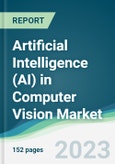Computer vision AI is a subcategory of artificial intelligence (AI) that utilizes AI technology, deep machine learning, and complex interconnected neural networks to process digital visual input to obtain crucial insights or to achieve a targeted result. In an AI-assisted computer vision system, visual input is scanned through a sensing device to produce an output after passing it through an inferring device.
AI in computer vision can perform numerous attributes such as face recognition, image detection, moving object detection, grouping of images, object segmentation, future prediction based on past trends, and observation of moving targets. The convenience and versatility of computer vision in AI result in its application in different sectors, such as healthcare, agriculture, transportation, finance, cybersecurity, and retail. Hence, after considering the potential of AI in computer vision to evolve and increase its applications in different sectors, it can be anticipated that this market will experience a rapid expansion in the forecast period.
AI IN COMPUTER VISION MARKET DRIVERS:
- Growing demand for AI in computer vision from the agricultural sector is anticipated to accelerate the market expansion.
In addition, computer vision AI can assist in improving crop yield and productivity by detecting harmful weeds or issues with crop health. Its applications can further analyze new hybrid crops' color, texture, and quality to check their compatibility with the soil. For instance, companies like Descartes Labs and Blue River Technology are actively providing computer vision AI services to agricultural companies and investing in expanding their product portfolio in this field.
AI In Computer Vision Market Geographical Outlook:
- North America to hold significant shares of AI in the computer vision market.
In addition, giant technology companies like Google, Microsoft, and IBM are actively investing in developing new AI software, including computer vision AI. There is a rise in the adoption of computer vision AI across various sectors such as agriculture, manufacturing, automotive, and information technology in North American countries like the USA and Canada. This will result in an increase in the market size of North American computer vision AI over the forecast period.
Reasons for buying this report::
- Insightful Analysis: Gain detailed market insights covering major as well as emerging geographical regions, focusing on customer segments, government policies and socio-economic factors, consumer preferences, industry verticals, other sub- segments.
- Competitive Landscape: Understand the strategic maneuvers employed by key players globally to understand possible market penetration with the correct strategy.
- Market Drivers & Future Trends: Explore the dynamic factors and pivotal market trends and how they will shape up future market developments.
- Actionable Recommendations: Utilize the insights to exercise strategic decision to uncover new business streams and revenues in a dynamic environment.
- Caters to a Wide Audience: Beneficial and cost-effective for startups, research institutions, consultants, SMEs, and large enterprises.
What do businesses use our reports for?
Industry and Market Insights, Opportunity Assessment, Product Demand Forecasting, Market Entry Strategy, Geographical Expansion, Capital Investment Decisions, Regulatory Framework & Implications, New Product Development, Competitive IntelligenceReport Coverage:
- Historical data & forecasts from 2022 to 2029
- Growth Opportunities, Challenges, Supply Chain Outlook, Regulatory Framework, Customer Behaviour, and Trend Analysis
- Competitive Positioning, Strategies, and Market Share Analysis
- Revenue Growth and Forecast Assessment of segments and regions including countries
- Company Profiling (Strategies, Products, Financial Information, and Key Developments among others)
Market Segmentation:
The AI In Computer Vision Market is segmented and analyzed as below:- By Type
- Hardware
- Software
- By Product
- Smart Camera-based
- PC-based
- By Function
- Image Classification
- Object Detection
- Visual Inspection
- Others
- By Applications
- Automotive
- Consumer Electronics
- Healthcare
- Manufacturing
- Retail
- Others
- By Geography
- North America
- USA
- Canada
- Mexico
- South America
- Brazil
- Argentina
- Others
- Europe
- United Kingdom
- Germany
- France
- Italy
- Spain
- Others
- Middle East and Africa
- Saudi Arabia
- UAE
- Others
- Asia Pacific
- China
- Japan
- India
- South Korea
- Australia
- Indonesia
- Others
- North America
Table of Contents
Companies Mentioned
Some of the key companies profiled in this Artificial Intelligence (AI) in Computer Vision Market report include:- NVIDIA
- IBM Corporation
- Intel Corporation
- Microsoft Corporation
- AWS Inc.
- Qualcomm Technologies Inc.
- Xilinx (AMD Inc.)
- Google LLC
- Basler AG
- Keyence Corporation
Table Information
| Report Attribute | Details |
|---|---|
| No. of Pages | 152 |
| Published | September 2024 |
| Forecast Period | 2024 - 2029 |
| Estimated Market Value ( USD | $ 17.67 billion |
| Forecasted Market Value ( USD | $ 55.08 billion |
| Compound Annual Growth Rate | 25.5% |
| Regions Covered | Global |
| No. of Companies Mentioned | 10 |









